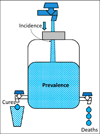Epidemiology and Clinical Research Design, Part 2: Principles
- PMID: 26236171
- PMCID: PMC4517623
- DOI: 10.1542/neo.16-2-e94
Epidemiology and Clinical Research Design, Part 2: Principles
Abstract
This is the third article covering core knowledge in scholarly activities for neonatal physicians. In this article, we discuss various principles of epidemiology and clinical research design. A basic knowledge of these principles is necessary for conducting clinical research and for proper interpretation of studies. This article reviews bias and confounding, causation, incidence and prevalence, decision analysis, cost-effectiveness, sensitivity analysis, and measurement.
Figures












Similar articles
-
The future of Cochrane Neonatal.Early Hum Dev. 2020 Nov;150:105191. doi: 10.1016/j.earlhumdev.2020.105191. Epub 2020 Sep 12. Early Hum Dev. 2020. PMID: 33036834
-
Causation, bias and confounding: a hitchhiker's guide to the epidemiological galaxy Part 2. Principles of causality in epidemiological research: confounding, effect modification and strength of association.J Fam Plann Reprod Health Care. 2008 Jul;34(3):185-90. doi: 10.1783/147118908784734873. J Fam Plann Reprod Health Care. 2008. PMID: 18577320 Review. No abstract available.
-
Good research practices for comparative effectiveness research: approaches to mitigate bias and confounding in the design of nonrandomized studies of treatment effects using secondary data sources: the International Society for Pharmacoeconomics and Outcomes Research Good Research Practices for Retrospective Database Analysis Task Force Report--Part II.Value Health. 2009 Nov-Dec;12(8):1053-61. doi: 10.1111/j.1524-4733.2009.00601.x. Epub 2009 Sep 10. Value Health. 2009. PMID: 19744292
-
Causation, bias and confounding: a hitchhiker's guide to the epidemiological galaxy. Part 1. Principles of causality in epidemiological research: time order, specification of the study base and specificity.J Fam Plann Reprod Health Care. 2008 Apr;34(2):83-7. J Fam Plann Reprod Health Care. 2008. PMID: 18413019 Review. No abstract available.
-
[Clinical epidemiology--the basis for evidence-based medicine].Cas Lek Cesk. 2003 Feb;142(2):67-9. Cas Lek Cesk. 2003. PMID: 12698530 Czech.
Cited by
-
The Impact of Dairy Products in the Development of Type 2 Diabetes: Where Does the Evidence Stand in 2019?Adv Nutr. 2019 Nov 1;10(6):1066-1075. doi: 10.1093/advances/nmz050. Adv Nutr. 2019. PMID: 31124561 Free PMC article. Review.
-
Validity of the Brief Child and Family Phone Interview by comparison with Longitudinal Expert All Data diagnoses in outpatients.Scand J Child Adolesc Psychiatr Psychol. 2020 Oct 18;6(2):83-90. doi: 10.21307/sjcapp-2018-009. eCollection 2018. Scand J Child Adolesc Psychiatr Psychol. 2020. PMID: 33520755 Free PMC article.
References
-
- Brodsky D, Martin C. Neonatology Review. Kidlington, United Kingdom: Hanley & Belfus; 2003.
-
- Cordis L. Epidemiology: With Student Consult Online Access. Amsterdam, the Netherlands: Elsevier Health Sciences; 2013.
-
- Guyatt GH, Rennie D, Meade MO, Cook DJ. User’s Guide to the Medical literature a manual for evidence-based clinical practice. 2nd edition. New York: NY McGraw Hill; 2008.
-
- Hermansen M. Biostatistics: Some Basic Concepts. Gainesville, FL: Caduceus Medical Publishers; 1990.
-
- Hulley SB, Cummings SR, Browner WS, Grady DG, Newman TB. Designing Clinical Research. Baltimore, MD: Wolters Kluwer Health; 2013.
Grants and funding
LinkOut - more resources
Full Text Sources
Other Literature Sources

